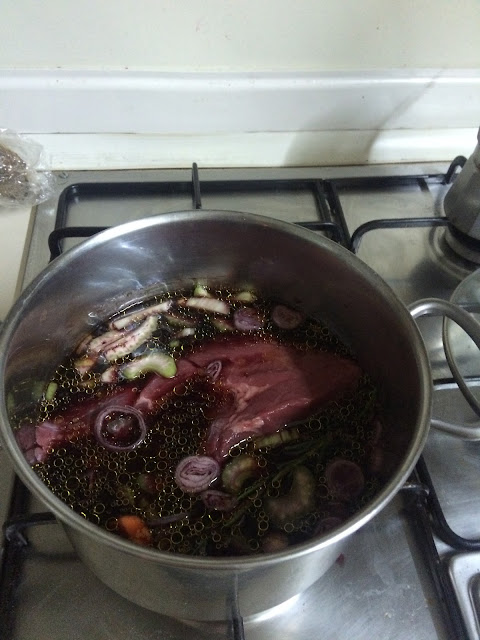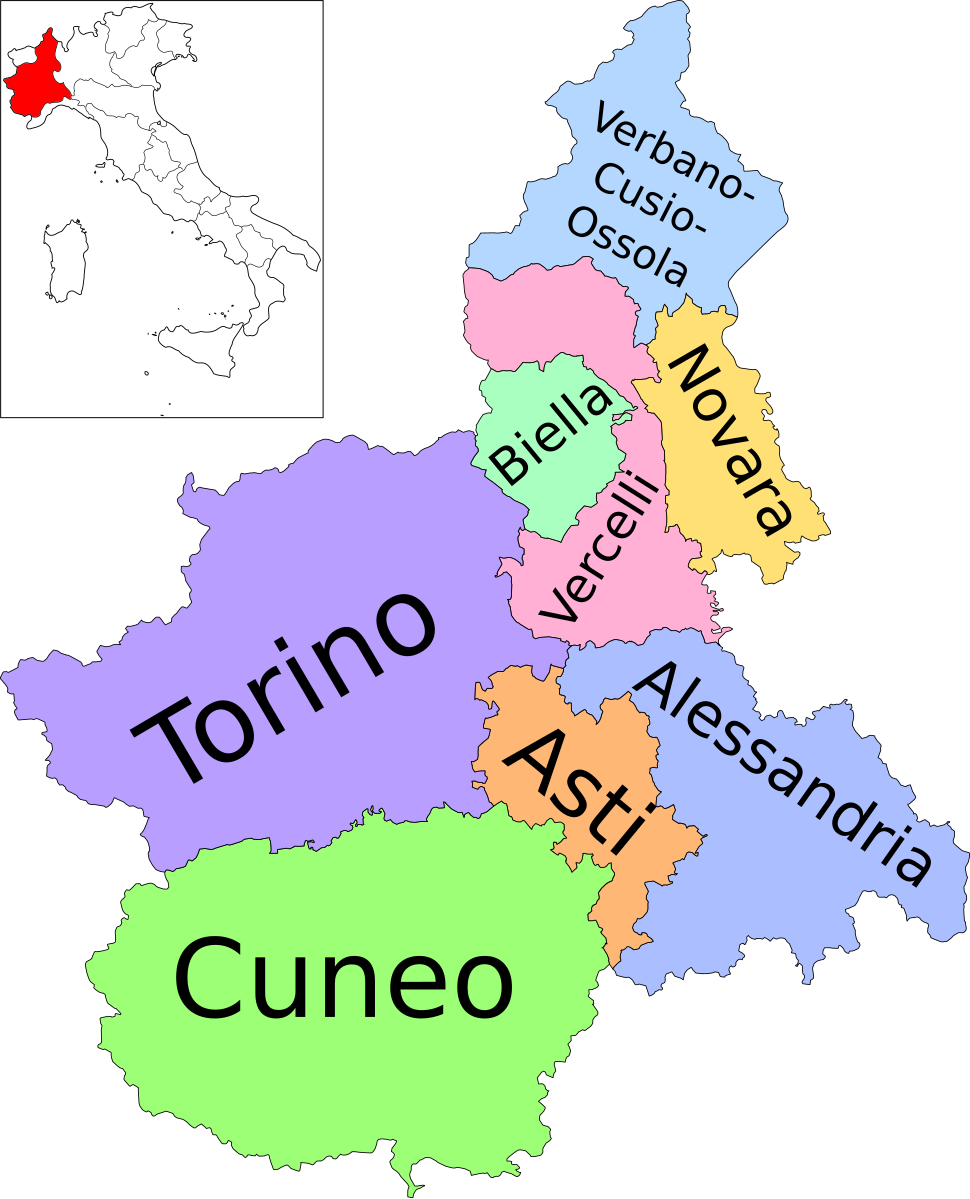Hello again readers! I've been doing quite a bit of grading for my class lately and, as any grad student knows, this is a task made much easier with a glass of wine in your hand. So, it seemed like a good time for a new wine post. Facebook also keeps reminding me that it's been seven years (groan...) since I was first in Italy during my semester abroad in Alba, a small town in the Piemonte region, near Torino. I thought I'd use this post to talk about the famous wines of this northern region, often considered to be the best in Italy.
Before Italy unified in the 1860s Piemonte was part of the Kingdom of Piedmont-Sardinia, ruled from Torino (better known in English as Turin, of Shroud fame) by the House of Savoy. These Savoy kings would go on to unite Italy into the modern country (with the help of Count Cavour and General Garibaldi, of course), and for a brief time the new country was actually ruled from this northern capital.
Piemonte is home to a large number of DOC and DOCG wines, and several of these are considered among the best wines of the world (and certainly the most well-known). Along with Toscano and Veneto, it's one of the principal wine regions of the country (in terms of quality, if not in volume).. Let's start with the inspiration for the title of the post: Barolo.
 |
| The areas of Piemonte that have DOC and DOCG regulations |
Often referred to as "the king of wines and the wine of kings" thanks to its popularity among the nobility of Savoy Torino, Barolo is the most well-known Piemontese wine, though in terms of volume it is extremely low. One of the first Italian wines to receive DOCG status, Barolo has a number of very strict production guidelines, including a lengthy aging period (38+ months, 18+ of which must be in wood barrels rather than the bottles) and a very limited geographic zone of production (as you can see above. The area is only 5 miles across at its widest point). Furthermore, the wine must be made of 100% Nebbiolo grapes. This grape is the most famous in Piemonte, and is also notoriously difficult to grow properly, budding early and ripening very late, and requiring a very dry climate just before harvest in late October. In addition to the difficulties in producing the wine, Barolo really needs to be aged for a significant amount of time after release to really be ready to drink, due to the very high levels of harsh tannins. A decade may be long enough, but the best vintages can hold up for much, much longer, half a century or more. These wines tend to be bold and intense, with lots of earthy notes along with some fruit, depending on the producer and the style. The stereotypical way to describe the aroma is "tar and roses". The small volume of production, need for long aging, and international reputation mean that Barolo doesn't come even remotely cheap; expect to spend at least $100 on a ready-to-drink bottle of the good stuff, and the sky is the limit from there. I honestly can't make a recommendation for what producer to try, as this is well outside of my price range (even here in Italy you won't find a decent bottle for under 50 euro), and quite frankly unless you are a real oenophile it's probably not worth the price of entry, except maybe as a display of conspicuous consumption to those around you. All that being said, while Barolo is undoubtedly the top dog in Piemonte, there are lots more choices that come with much less sticker shock, and much more value.
 |
| A glass and decanter of Barolo. Note the light color, which is a characteristic of the Nebbiolo grape. |
If Barolo is the king of wines, then Barbaresco--a close relative--would be the queen. Produced in an even smaller zone just to the north and east of Barolo, Barbaresco shares a number of characteristics with its sibling. It too must adhere to strict geographic limitations (a zone even smaller than Barolo) and aging requirements (2 years total, at least 1 of which must be in the bottle), and it too must be 100% Nebbiolo. Compared to Barolo, Barbaresco tends to be more approachable at a much younger age. Though still very tannic, these tannins tend to soften years earlier, the tradeoff being that they won't be able to age for quite as long. It's all relative though; you still want a bottle with 5+ years on it generally speaking, and a good bottle will still hold up for about 20 years. As for cost, for the very best examples you would still need to spend hundreds. But, you can get an excellent bottle of "Produttori del Barbaresco" for $20-30. This bottling is made by several of the Barbaresco producers in concert with one another, rather than only being from a single estate. 2010 was a particularly excellent year for Nebbiolo grapes, and is just hitting the sweet spot now. It will hold up for another decade at least, as well. I've had this specific bottle before, and it's probably the best wine I've ever tried. Expect intense, spicy aromas, with a good amount of fruit along with more spice on the palate. I'd also recommend decanting (or at least uncorking the bottle and pouring a bit into a glass, to increase the surface area) for at least 2 hours before drinking, as this really lets the wine open up a bit. If you don't, the tannins can be overpowering.
 |
| The 2011 is also quite good, and the 2006 should be *superb*, if you can find it |
In addition to these two powerhouses, you can also find wines simply named "Nebbiolo", made of the same grapes and often in the same locations as Barolo and Barbaresco, but that don't adhere to the same production guidelines. These wines are meant to be consumed much younger (within a few years of bottling, usually), and accordingly they tend to be much more fruit-forward and approachable. You may be asking yourself how much of the differences between these three Nebbiolo-based wines are based on snobbery and people with more money than sense. This is probably partly true, and consumer expectations certainly can shape the wines that get made. In addition, however, some grapes are much more susceptible than others to variations in geography and climate (referred to as terroir), and Nebbiolo happens to be one of those grapes. The Piemonte region also varies greatly over small distances, unsurprising given that is at the foot of the Alps.
Nebbiolo is hardly the only grape grown in Piemonte, even if it is used in the most famous wines. One of the local favorites of the region is Dolcetto, which translates to "little sweet one." Make no mistake though, the wine is definitely dry. This grape is typically grown on the less desirable areas of vineyards, where Nebbiolo would typically not thrive. The grape is much easier to grow, and the resulting wine much less fussy than those mentioned above. It is also much darker in color, much more purple than the brick reds of Nebbiolo wines. You can expect flavors of black fruits (think black cherry, raisin, prune, etc.), still with a healthy serving of tannins. Unlike Barolo or Barbaresco, these wines are definitely not meant to be aged, and you should be looking for bottles that are just a few years old. Expect to pay $13-20 for a bottle in the US. Dolcetto is easy to drink and fairly light, so don't overthink it. Order a pizza and drink up.
 |
| Compare this color to the Barolo above |
The last of the major red varieties produced in Piemonte is Barbera. One of my personal favorites, Barbera is another varietal that is much more for everyday drinking rather than special occasions. In some ways it's the opposite of Dolcetto: it has flavors of red fruits and berries instead of black fruits, and has pretty low tannins and high acidity, instead of higher tannins and low(ish) acidity. The high acidity means that it pairs well with lots of foods. It's planted in other regions of Italy as well, and is one of the highest volume grapes in the country. Unlike most other Piemonte grapes, it's also grown around the world, with excellent examples even from the East Coast of the US (try Woodhall's, from Maryland!). For a Barbera d'Alba or Barbera d'Asti, you can expect to spend $13-20, though you can spend much more if you want to.
In addition to these very well known reds, Piemonte produces several world-class white wines. The most famous of these is now simply known as "Asti", though you probably know it better as Asti Spumante. This is a sparkling wine similar in some ways to Champagne, though it gets its carbonation in a different manner. This wine is made from the Moscato grape, and is often made as a sweet dessert wine. Like many sparkling wines, Asti is generally produced as "non vintage," meaning that no year is indicated on the label. This means that the product is going to be pretty consistent, bottle to bottle, year after year. In the US, you'll find this bottle in almost any liquor store, for under $20 a bottle.

Related to Asti is a wine called Moscato d'Asti, also made from Moscato grapes and also generally a sweet wine. The biggest difference is the level of carbonation. Where Asti is very carbonated, Moscato d'Asti is known as "frizzante," fizzy. Think Coca Cola vs. San Pellegrino and you've got the idea. This can be quite a tasty wine, and much higher quality than much of the Moscato that occupies so much US shelf space. The "d'Asti" part is important, as this means that the wine is made in the Piemonte area and not just from the Moscato grape. Even Cupcake makes a Moscato d'Asti these days, so you don't have to break the bank for something authentic if you like sweet wines.
 |
| Just not this. NEVER THIS. |
To finish up, I want to touch on a white wine that I discovered over the summer from Piemonte. Unlike the above two, this is a dry rather than a sweet wine, and it's produced a bit farther to the east in Piemonte. Before most of Italy's white wine for export came from the Veneto (as the overwhelming majority of Pinot Grigio in the US does), Gavi was the "standard" Italian white. I was pleasantly surprised when I tried it, as it was a nice change of pace from the now-typical Pinot Grigio. I found it to be a little more full-bodied (though not so much so as a Chardonnay), but still crisp and refreshing. I don't know how easy it may be to track down, but it's worth looking a bit.
That should do it! I hope to have a new food post up in the next couple days, and on Friday I'm off to Rome!. Thanks for reading.














